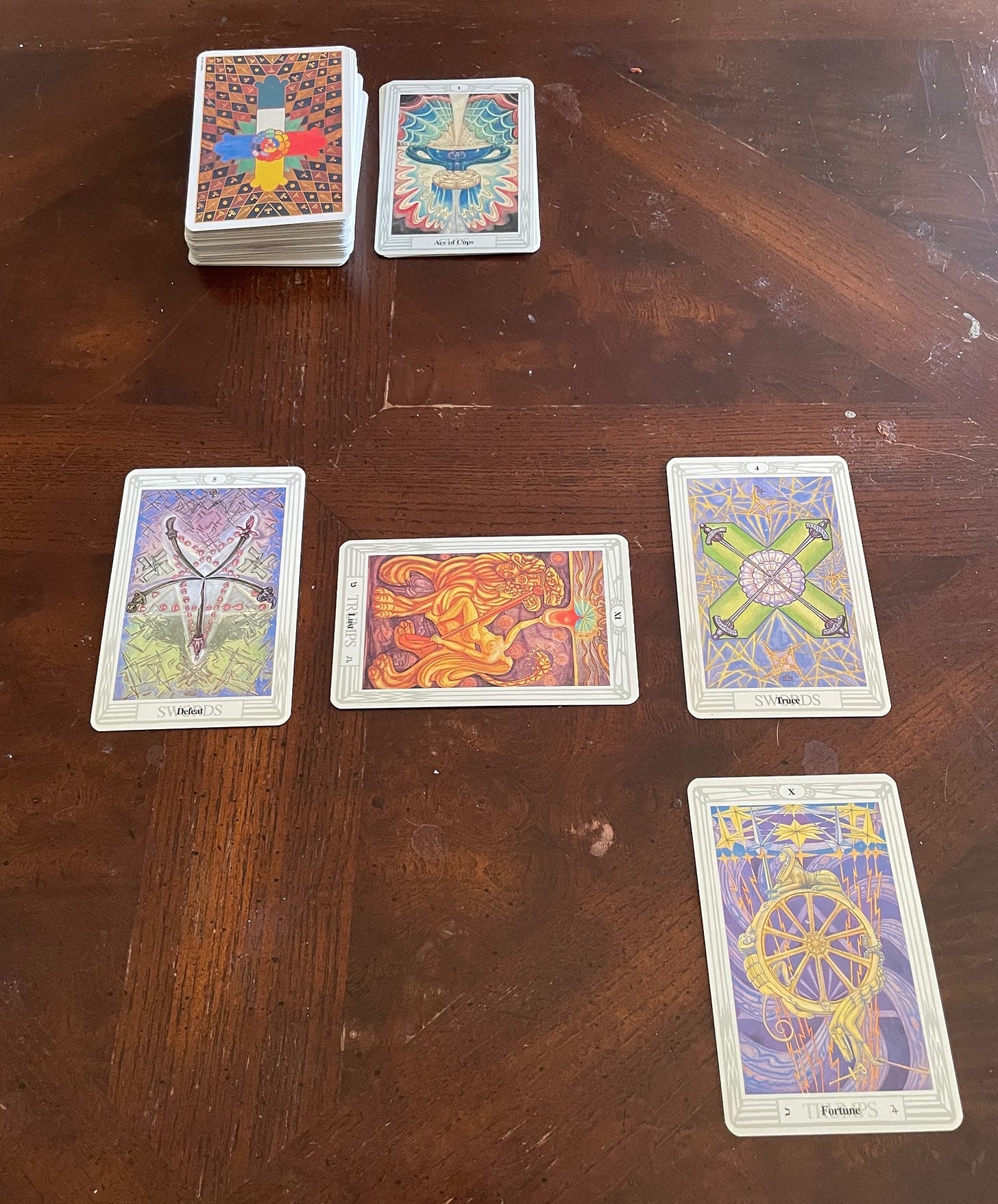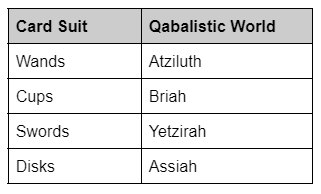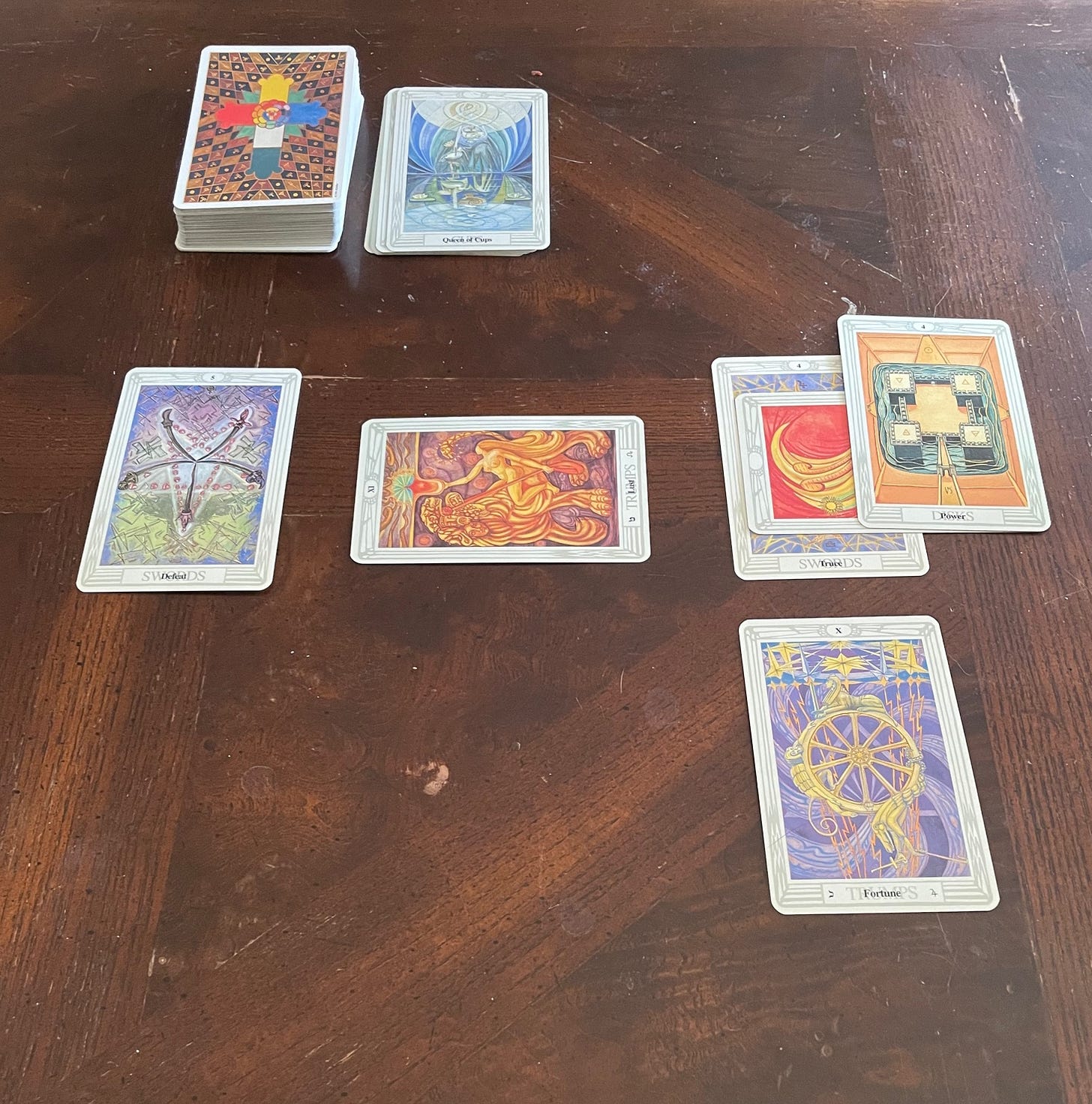In Qabalistic philosophy, the Tree of Life consists of ten emanations, or Sephiroth, which are connected by twenty-two paths. In addition, there are actually four Trees, each overlaid on top of another, to correspond to the Four Qabalistic Worlds of Atziluth, Briah, Yetzirah, and Assiah.
Four Worlds is a card game for 2-4 people that uses one Thoth tarot deck, this four-fold Qabalistic model and tarot correspondences to the Tree of Life found in Aleister Crowley’s book 777. Players draw and discard, and try to create their own path along the Tree.
The Cards
The Thoth deck is divided into three types of cards: The Minor Arcana, The Major Arcana, and Court Cards.
The Minor Arcana are the 40 cards of different suits: Wands, Cups, Swords, and Disks. These cards numbered 1-10 correspond to the ten numbered Sephiroth on the Tree of Life.
The suits of the Minor Arcana cards correspond to the Four Qabalistic Worlds as shown below.
Thus, each of the Minor Arcana cards has two identities. The number of the card places it on the Tree of Life as one of the Sephiroth. The suit of the card places it in one of the Four Worlds. For example, the Six of Wands represents Tiphereth in Atziluth, and the Ten of Disks represents Malkuth in Assiah. Players use the Minor Arcana cards to stake out and expand their position on the Tree starting off in one of the Four Worlds.
The Major Arcana of the Thoth deck are the 22 cards that correspond to the paths in between the Sephiroth, i.e. The Fool, The Magus, The Empress, etc. When played in the game, these cards allow players to connect Minor Arcana cards and build a path along the Tree (see Figure 1).
The 16 Court cards are the royal cards of the deck. There is a Knight, Queen, Prince, and Princess in each suit. These cards rule the Four Qabalistic Worlds as designated by their suit (see Figure 3). Additionally, the rank of the Court Card identifies it as a gatekeeper to one of the Worlds (see Figure 4).
Playing the Game
The Basics
The deck is shuffled. Each player is dealt seven cards. The remaining cards are put face down in the middle of the table to be the draw pile. Discards will be placed face up next to the draw pile. When the draw pile is gone, the discard pile is shuffled and becomes the new draw pile.
A starting player is selected by any acceptable method. Players take turns going deosil (clockwise) around the table.
The Turns
On their turn, a player draws a card from either the draw pile or the discard pile and adds it to her hand. The player must then either play a card on the table by laying it down in front of them, or discard if no card is played. Discards are placed face up next to the draw pile. When a player draws and discards, ther turn is over.
More than one card may be played during a turn. Cards are placed in front of the player in relative position to the Sephiroth and Paths as shown on the Tree of Life diagram. Once the player has played all the cards they can, they declare that their turn is over. There is no discard in a turn when cards are played. If the player ends up with fewer than seven cards, he draws additional cards from the draw pile so that he once again has seven cards at the end of his turn.
Playing the Minor and Major Arcana Cards
The first card a player lays down must be a Minor Arcana card. This establishes the player’s starting position on the Tree. The card number (1-10) identifies which Sephirah the player has claimed. The card suit identifies which of the Four Worlds the player is working in (see figure 2 and figure 3).
Players alternate playing Minor and Major Arcana cards to form a path and expand their presence outward from their starting point on the Tree. Only cards that connect with existing cards on the table may be played. For example, a player who has laid down the Five of Wands and wants to expand from there can only play the four Major Arcana cards leading from Geburah (The Chariot, Lust, Adjustment, and The Hanged Man).
Cards are played in front of the player, placed in relation to the other cards as shown on the Tree of Life diagram (see Figure 1) to build a Tree. When a Major Arcana card is played, it applies to all Worlds in which the player may be working.

Playing the Court Cards
Method 1: Wildcard The Court Cards can be used as a wildcard to represent a Major Arcana card which is already in play. The Court Card played as a wildcard must be of the same suit as the Minor Arcana cards being connected, but can be any rank. It is placed on the table as if it were the intended Major Arcana card.
For example, Player 1 has played the Ten of Swords and needs the Universe card to connect it with the Nine of Swords in their hand, but Player 2 has already played the Universe card. Player 1 can play any Court Card of Swords (Knight, Queen, Prince, or Princess) they may have in their hand as a substitute for the Universe card by simple declaration.
Court Cards cannot be used as a wildcard for a card which is not already in play.
Method 2: Gatekeeper Court Cards can be used as a gatekeeper to unlock the path leading into an adjacent Qabalistic World. Because of the stacked nature of the four Trees (one Tree for each of the Worlds), each Sephirah on the Tree connects to a counterpart Sephirah in an adjacent World, either above it, or below it, or both.
The rank of the Court Card determines the World to which it can give access, shown in the table below.
Using a Court Card in this way is a two-card play. The player places the Court Card sideways over the established Sephirah card and then places the Sephirah card for the new World which is being unlocked over the Court Card. The player can now begin playing both suits of the Minor Arcana simultaneously.
For example, Player 1 has played the Four of Swords, establishing Chesed in Yetzirah. Using any Queen card and the Four of Cups, they can unlock access to Briah and begin playing Cup cards from Chesed in Briah. Similarly, using any Princess card and the Four of Disks, they could access Assiah and begin playing Disk cards.
In this way, players can build paths into all four Trees at the same time.
Method 3: Connecting Assiah and Atziluth The Sephirah Malkuth in Assiah is the one exception to the rule that says players can only open up an adjacent Qabalistic World. All Sephiroth in Assiah can access the next World up (Yetzirah), but Malkuth, being the bottom-most Sephirah of the bottom-most Qabalistic World, has a special place on the Tree of LIfe.
A gateway between Malkuth in Assiah (Ten of Disks) and Kether in Atziluth (Ace of Wands) can be opened using the Princess of Disks and the Ace of Wands. The Princess card is placed sideways on the Ten like any other gatekeeper card, and the Ace of Wands goes on top. Players who accomplish this operation now have access to Atziluth and can play Wand cards.
The End of the Game
When there are no cards left to draw from, it marks the final turn of the game. Players get one last turn to play cards and complete their Great Work. A point scoring system shows how well players did.
1 point for each Sephirah card played
1 point for each Path card played (including any Court wildcards)
2 points for each Court card played as a gatekeeper
3 bonus points for accomplishing the Assiah-Atziluth connection
Four Worlds Variations
Four Players - One Tree In this variation of Four Worlds, up to four players work together to build one Tree of Life. Each player takes turns to fill in all positions using one deck of Tarot cards. The game ends when all Sephiroth are connected by all Paths. Minor arcana can be stacked in any order. Court cards are not used.
Pairs Two teams of two players compete against each other to build their own Tree of Life using one deck of Tarot cards. Standard rules apply.
Middle Pillar (Race to the Top) Using multiple decks (one per player) either combined together into one draw pile OR played individually, players must start at Malkuth and work their way to Kether. The winner is the one who gets to Kether first by using the fewest cards. Standard rules apply, with the exception that the first card played must be one of the 10s.
Card Trading An optional action during a turn, players can opt to trade one card from their hand with another player at the start of their turn instead of drawing a card from the deck.
© Mystic Beauty, all rights reserved










